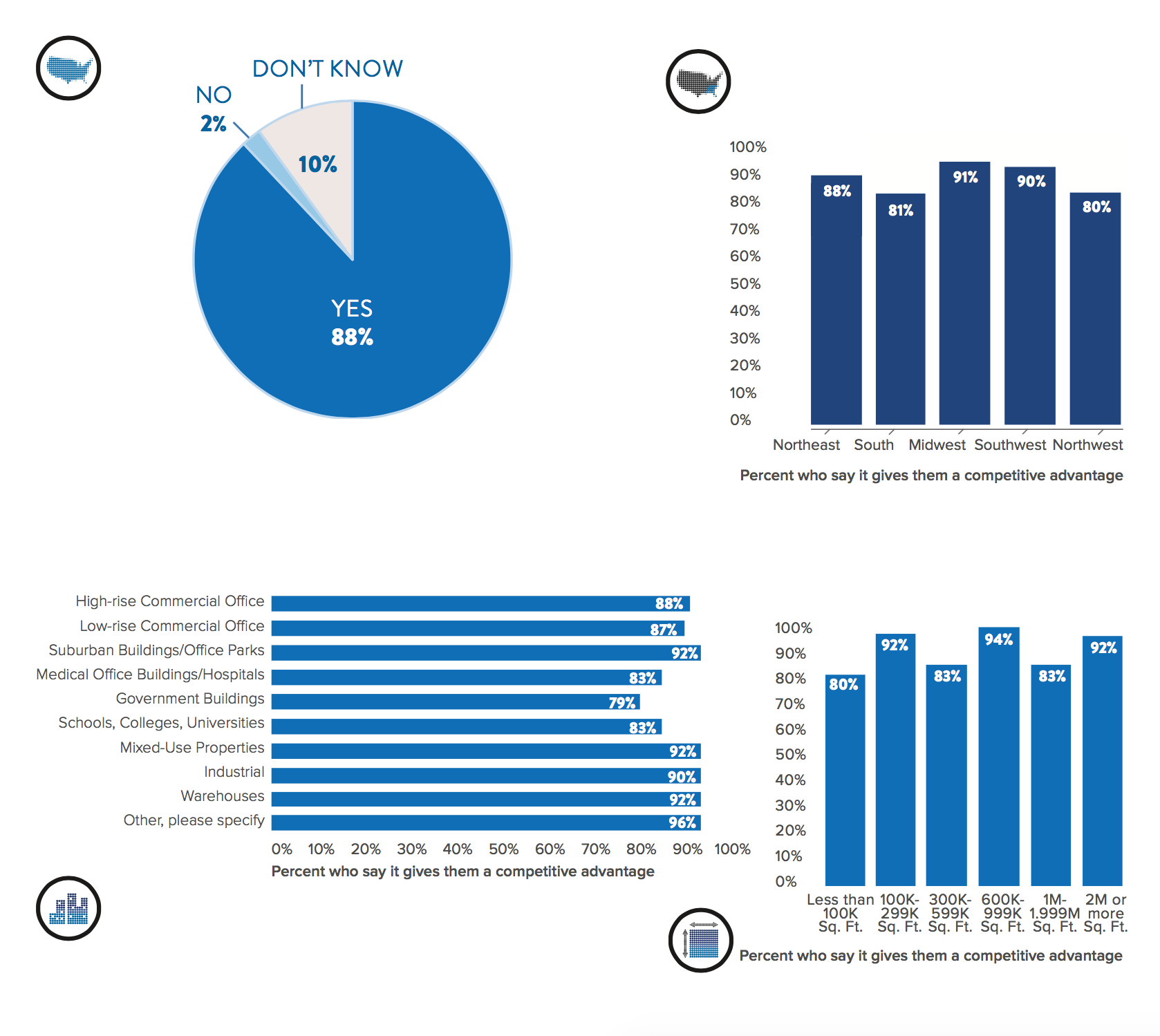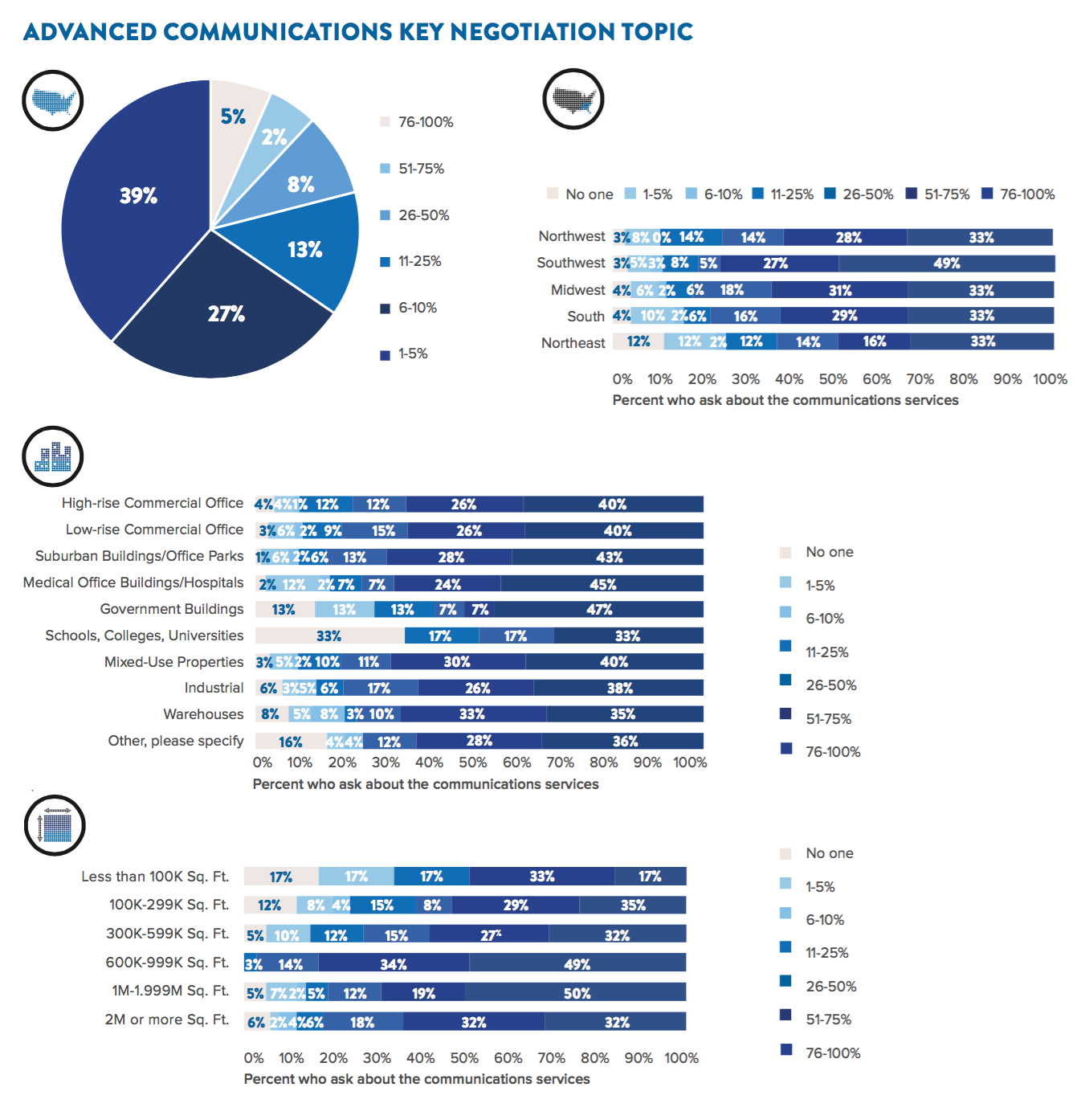The State of Communications Services in Commercial Real Estate

Executive Summary
The location of its building is one of the most important decisions that a business can make – affecting employees, customers and others who work with the company. However, no two tenants are alike, with each one having a unique set of office space requirements based on their industry. For example, the type of building, location and amenities required by a large financial services firm are vastly different from an e-commerce warehouse or graphic design agency.
To better understand the priorities of this decision process, nearly 200 U.S. building owners and property managers were surveyed for their opinions on the importance of advanced communications services. While location is still a fundamental filter in the selection process, the criteria used to compare buildings are increasingly shifting in importance as a result of broader business trends and regulatory compliance issues.
Fundamental drivers of these changes include a cumulative business reliance on high-performance networks. While these networks initially improved business efficiency through interconnection with suppliers and partners or provided a means to meet government regulations for off- site back-ups, their role is now expanding.
Faster networks now enable businesses of all sizes to outsource their IT infrastructure, applications and services to managed hosting, cloud services and Software-as-a-Service (SaaS) providers. This helps lower their IT costs and improve efficiency, but also turns a secure, reliable, high-performance network connection into a mission-critical business asset.
This new reality – or the rise of the “hyper-connected business” – is reflected in the key findings about the importance of advanced communications services in this State of Communications Services in Commercial Real Estate report.
95% of building owners and property managers say that access to advanced communications services is a key selling point behind only location and price.
88% of building owners and property managers believe that having advanced communications services in their buildings provide them with a competitive advantage.
Over one third of building owners and property managers say that in 75% of negotiations with prospective tenants, the topic of access to advanced communications services is discussed
Key Findings and Recommendations
Hyper-connected Tenants Demand Access to Advanced Communications
The definition of the workplace is changing. A few years ago, a business might have had email servers in its office, back- up files to tape storage in its own IT room, and hold team meetings in an office conference room. Today, the company’s email is likely a cloud service with its storage backed up to a data center across the country and team meetings held via video conferencing. Worldwide spending on public cloud services is expected to double by 2019, according to International Data Corporation (IDC). It will grow at a 19.4% compound annual growth rate (CAGR) – almost six times the rate of overall IT spending growth – from nearly $70 billion in 2015 to more than $141 billion in 2019.* So, if companies are requiring fast, reliable network connections for their business, are building owners and property managers addressing their needs and highlighting available options? The survey asked:
How important a selling point do building owners and managers consider access to advanced telecommunications services?
Key Findings
- 95% of respondents said that access to advanced communications services is a key selling point behind only location and price.
- In 2014, advanced communications displaced “access to parking”** among the top three selling points, including location and price, for most types of commercial properties***, except for government buildings (ranked fourth) and educational properties (ranked seventh).
- For property owners in the Northwest, access to advanced communications tied with location as their number one selling point.

Recommended Next Step
Add Advanced Communications Services to Your Sales and Marketing Materials – Once they have made sure their properties have the right communications infrastructure, building owners and property managers should ensure that their marketing and sales materials list out the advanced communications services and providers available in their buildings so these key selling points stand out for prospective tenants. In addition, highlight network access points, data rooms or other on-site communications facilities when giving tours of properties and ensure that brokers are knowledgeable about what advanced communications services are offered in each building and the benefits to prospective tenants.
A “Cloud-ready” Building is a Competitive Advantage for Property Owners and Managers
As businesses increasingly rely on network connections for their day-to-day operations, ensuring that those connections are modern and reliable translates into more uptime, revenue and customer satisfaction, regardless of a tenant’s industry. The survey wanted to probe beyond simply asking if access to advanced communications services was an important selection priority for tenants, and aimed to discover if it had started to become proactively recognized as a valuable asset and competitive advantage for buildings. The survey asked:
Does offering advanced telecommunications services give you a competitive advantage?
Key Findings
- 88% of respondents believe that having advanced communications services in their buildings provide them with a competitive advantage, and a similar average holds true when broken down by property type.
- More than 1/3 of Southwestern property managers consider advanced communications to be a large advantage.
- Sixty percent of property managers (with less than 100,000 square feet) also consider it to be a large advantage. A clear majority of building owners and property managers consistently view advanced communications services as a competitive advantage, regardless of their square footage under management, property type or regional location.

Recommended Next Step
Perform a Competitive Assessment – Building owners and property managers should proactively do an advanced communications services audit that covers what service providers and associated products, services and prices are available in their properties as compared to competitive properties in the area that tenants typically consider before leasing office space. This will help them analyze, validate, position, and communicate their competitive advantage and identify and fill in any gaps in access to advanced communications services.
Advanced Communications Services is a Frequently Raised Topic During Negotiations with Prospective Tenants
In today’s challenging economy and competitive real estate market, the negotiation between a building owner and a tenant is even more important to both parties involved, since the outcome represents a fixed amount of revenue and cost, respectively, for years to come. In addition to negotiating the lease rate, which is still the top priority, other terms and details need to be discussed and negotiated, such as who is responsible for maintenance, how the space can be used, and early termination details.
And, while lease rates may not have much room for negotiation (depending on the location and property type), other items may be more negotiable while also being very important to tenants. Clearly, access to advanced communications services is an important selection criteria and selling point, so does it come up in negotiations? The survey asked:
What percent of new and prospective tenants ask you about the communications services available in your building?
Key Findings
- Over one-third of respondents say that in 75% of negotiations with prospective tenants, the topic of advanced communications is raised. This also is true when looking at each region.
- When looking at property type, the national average increases to almost half (46%) for respondents that own or manage suburban office buildings.
Based on this data, there is a high probability that building owners and property managers will face the topic of advanced communications in future discussions with prospective or current tenants. Those who do not already have access to advanced communications services should, at a minimum, be prepared to discuss their plan for bringing these services into their buildings in the future, and be aware of the available service providers in their particular area.

Recommended Next Step
Don’t Wait, Be Proactive – Building owners and property managers should not wait for tenants to ask about a building’s advanced communications infrastructure and instead take the time to understand the tenant’s business and potential applications as well as services needed to run it (video conferencing, SaaS, digital imaging, etc.) and proactively discuss how the building’s advanced communications infrastructure is suited to those needs.
Methodology & Respondent Profile
To better understand the role advanced communications services play in attracting tenants to commercial properties, Comcast Business conducted an October 2014 survey of 6000 U.S. commercial real estate owners and managers who are members of the Building Owners and Managers Association (BOMA) International.
The overall response rate to the survey was 3.3%, represented by 196 respondents who manage from one to more than 50 buildings with less than 100,000 square feet to more than two million square feet. Respondents also manage a wide range of properties, including high-rise commercial offices, low-rise commercial office, suburban buildings/office parks, mixed-use properties, industrial, medical office buildings, warehouses, education buildings and government buildings.
Their answers provide a comprehensive perspective on the state of advanced communications in commercial real estate today.
Conclusion
According to 451 Research (Market Monitor and Forecast), the market for cloud computing ‘as a service’ – which includes PaaS, IaaS and infrastructure software as a service (ITSM, backup, archiving) – will hit $21.9B in 2016 more than doubling to $44.2B by 2020.**** It’s clear that hyper-connected businesses are increasingly relying on cloud computing, SaaS, business continuity/disaster recovery and other high- bandwidth applications. This not only makes having a highly reliable network connection essential, but it also makes the advanced communications infrastructure of a company’s office space a key part of its IT strategy and daily operations.
With this trend as a backdrop, and operating in a challenging economy and competitive commercial real estate market, building owners and property managers are looking for any advantage to attract and retain tenants – and are increasingly finding this advantage with advanced communications services.
Based on the survey results, access to advanced communications has become a very important part of the building selection process for new and prospective tenants, is viewed as a competitive advantage, can positively impact occupancy rates, and is often asked about during negotiations with prospective tenants.
In order to attract and retain tenants, building owners and property managers need to provide connectivity to advanced communications services – if possible, from multiple service providers over diverse networks – in their buildings. Ensuring this and proactively marketing it to prospective tenants will add value and help differentiate building portfolios as the IT outsourcing trend accelerates.
*Source: Worldwide Semiannual Public Cloud Services Spending Guide.
**In a 2011 survey, 90% of respondents cited access to advanced communications as the fourth most important selling point, behind location, price and parking.
***High-rise commercial office buildings, low rise commercial office buildings, suburban office buildings/parks, medical office buildings/hospitals and industrial warehouses.
****Source: After a decade of dominance, what’s next for AWS?
The location of its building is one of the most important decisions that a business can make.
Locked Content
Click on the button below to get access
Unlock NowOr sign in to access all content on Comcast Business Community
Learn how Comcast Business can help
keep you ready for what's next.











